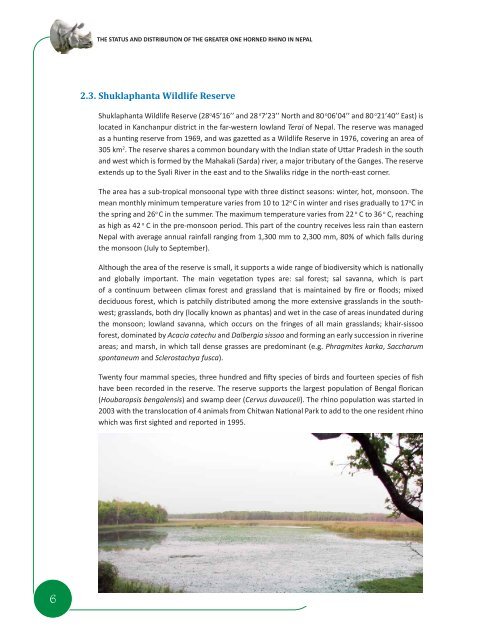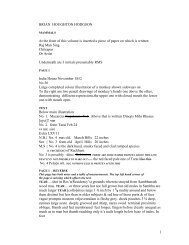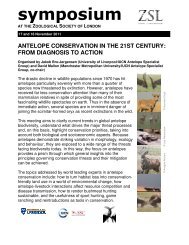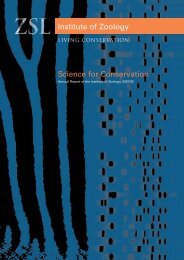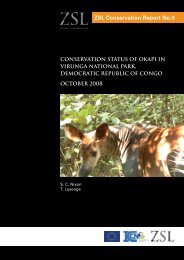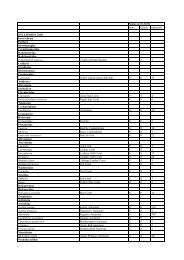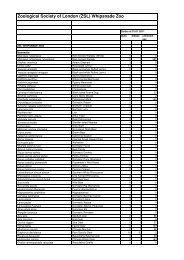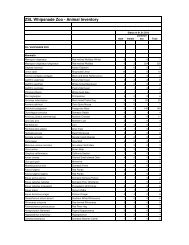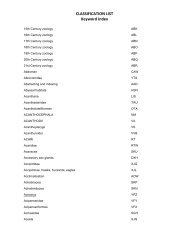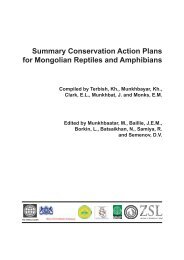the status and distribution of the greater one-horned rhino in nepal
the status and distribution of the greater one-horned rhino in nepal
the status and distribution of the greater one-horned rhino in nepal
Create successful ePaper yourself
Turn your PDF publications into a flip-book with our unique Google optimized e-Paper software.
6<br />
THE STATUS AND DISTRIBUTION OF THE GREATER ONE HORNED RHINO IN NEPAL<br />
2.3. Shuklaphanta Wildlife Reserve<br />
Shuklaphanta Wildlife Reserve (28 o 45’16’’ <strong>and</strong> 28 o 7’23’’ North <strong>and</strong> 80 o 06’04’’ <strong>and</strong> 80 o 21’40’’ East) is<br />
located <strong>in</strong> Kanchanpur district <strong>in</strong> <strong>the</strong> far-western lowl<strong>and</strong> Terai <strong>of</strong> Nepal. The reserve was managed<br />
as a hunti ng reserve from 1969, <strong>and</strong> was gazett ed as a Wildlife Reserve <strong>in</strong> 1976, cover<strong>in</strong>g an area <strong>of</strong><br />
305 km 2 . The reserve shares a common boundary with <strong>the</strong> Indian state <strong>of</strong> Utt ar Pradesh <strong>in</strong> <strong>the</strong> south<br />
<strong>and</strong> west which is formed by <strong>the</strong> Mahakali (Sarda) river, a major tributary <strong>of</strong> <strong>the</strong> Ganges. The reserve<br />
extends up to <strong>the</strong> Syali River <strong>in</strong> <strong>the</strong> east <strong>and</strong> to <strong>the</strong> Siwaliks ridge <strong>in</strong> <strong>the</strong> north-east corner.<br />
The area has a sub-tropical monsoonal type with three disti nct seasons: w<strong>in</strong>ter, hot, monsoon. The<br />
mean monthly m<strong>in</strong>imum temperature varies from 10 to 12 o C <strong>in</strong> w<strong>in</strong>ter <strong>and</strong> rises gradually to 17 o C <strong>in</strong><br />
<strong>the</strong> spr<strong>in</strong>g <strong>and</strong> 26 o C <strong>in</strong> <strong>the</strong> summer. The maximum temperature varies from 22 o C to 36 o C, reach<strong>in</strong>g<br />
as high as 42 o C <strong>in</strong> <strong>the</strong> pre-monsoon period. This part <strong>of</strong> <strong>the</strong> country receives less ra<strong>in</strong> than eastern<br />
Nepal with average annual ra<strong>in</strong>fall rang<strong>in</strong>g from 1,300 mm to 2,300 mm, 80% <strong>of</strong> which falls dur<strong>in</strong>g<br />
<strong>the</strong> monsoon (July to September).<br />
Although <strong>the</strong> area <strong>of</strong> <strong>the</strong> reserve is small, it supports a wide range <strong>of</strong> biodiversity which is nati onally<br />
<strong>and</strong> globally important. The ma<strong>in</strong> vegetati on types are: sal forest; sal savanna, which is part<br />
<strong>of</strong> a conti nuum between climax forest <strong>and</strong> grassl<strong>and</strong> that is ma<strong>in</strong>ta<strong>in</strong>ed by fi re or fl oods; mixed<br />
deciduous forest, which is patchily distributed among <strong>the</strong> more extensive grassl<strong>and</strong>s <strong>in</strong> <strong>the</strong> southwest;<br />
grassl<strong>and</strong>s, both dry (locally known as phantas) <strong>and</strong> wet <strong>in</strong> <strong>the</strong> case <strong>of</strong> areas <strong>in</strong>undated dur<strong>in</strong>g<br />
<strong>the</strong> monsoon; lowl<strong>and</strong> savanna, which occurs on <strong>the</strong> fr<strong>in</strong>ges <strong>of</strong> all ma<strong>in</strong> grassl<strong>and</strong>s; khair-sissoo<br />
forest, dom<strong>in</strong>ated by Acacia catechu <strong>and</strong> Dalbergia sissoo <strong>and</strong> form<strong>in</strong>g an early succession <strong>in</strong> river<strong>in</strong>e<br />
areas; <strong>and</strong> marsh, <strong>in</strong> which tall dense grasses are predom<strong>in</strong>ant (e.g. Phragmites karka, Saccharum<br />
spontaneum <strong>and</strong> Sclerostachya fusca).<br />
Twenty four mammal species, three hundred <strong>and</strong> fi ft y species <strong>of</strong> birds <strong>and</strong> fourteen species <strong>of</strong> fi sh<br />
have been recorded <strong>in</strong> <strong>the</strong> reserve. The reserve supports <strong>the</strong> largest populati on <strong>of</strong> Bengal fl orican<br />
(Houbaropsis bengalensis) <strong>and</strong> swamp deer (Cervus duvauceli). The <strong>rh<strong>in</strong>o</strong> populati on was started <strong>in</strong><br />
2003 with <strong>the</strong> translocati on <strong>of</strong> 4 animals from Chitwan Nati onal Park to add to <strong>the</strong> <strong>one</strong> resident <strong>rh<strong>in</strong>o</strong><br />
which was fi rst sighted <strong>and</strong> reported <strong>in</strong> 1995.


